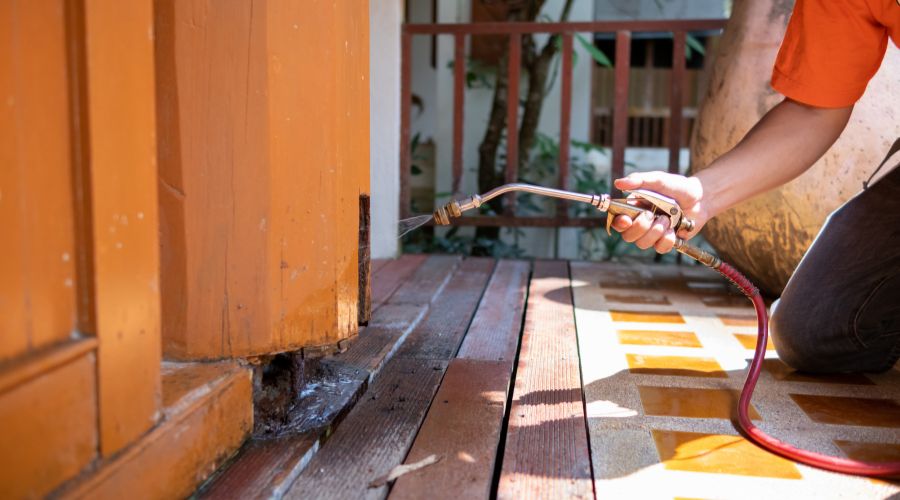Key Takeaways
- Early detection is crucial – Spot signs like mud tubes, hollow wood, or discarded wings.
- DIY termite removal methods can help but may not eliminate the entire infestation.
- Professional extermination is the most effective way to get rid of termites permanently.
- Preventative measures like sealing cracks and reducing moisture can stop termites from returning.
Why Are TERMITES in Your Home?
Termites are silent destroyers, feeding on wood and causing structural damage before homeowners even notice them. They thrive in damp, dark, and warm conditions, making basements, crawl spaces, and wooden structures prime targets.
Some common reasons termites invade homes include:
- Excess moisture from leaks or poor drainage.
- Wood-to-ground contact such as firewood near the house.
- Cracks and crevices in foundations or walls.
- Mulch and deadwood close to the home’s structure.
Best DIY Pest Removal Methods That Actually Work
Before calling in a professional, many homeowners attempt DIY solutions to eliminate termites. Here are some of the most effective DIY methods:
1. Use Boric Acid
Boric acid is a natural pesticide that dehydrates termites and disrupts their nervous system. Mix boric acid with water and spray it on infested areas or apply it as a dust around entry points.
2. Cardboard Trap Method
Since termites feed on cellulose, placing wet cardboard near an infestation can attract them. Once termites gather, remove and burn the trap.
3. Diatomaceous Earth (DE)
Sprinkle food-grade diatomaceous earth around termite-prone areas. DE cuts through the exoskeletons of termites, dehydrating and killing them over time.
4. Neem Oil or Orange Oil
These essential oils contain compounds that kill termites upon contact. Apply directly to termite nests or wooden structures for best results.
5. Nematodes (Beneficial Worms)
Nematodes are microscopic worms that feed on termites. Introduce them into the soil around your home to help eliminate underground colonies.
6. Vinegar and Lemon Juice Mixture
A homemade solution of white vinegar and lemon juice can act as a mild termite repellent when sprayed on infested areas.
While DIY solutions may offer temporary relief, they often fail to eliminate the colony entirely. For severe infestations, a professional exterminator is the best option.
When to Call a Professional Exterminator
There are situations where DIY treatments are not enough. Here’s when you should call an expert:
- Large infestations – If you notice widespread damage, hollowed wood, or extensive mud tubes.
- Recurring termite problems – If termites return after using DIY treatments.
- Structural damage – If floors feel weak, doors/windows stick, or there are visible holes in wooden furniture.
- Uncertain infestation location – Professionals have advanced tools like infrared cameras and moisture meters to detect hidden termite nests.
DIY vs. Professional TERMITES Extermination
| Factor | DIY Methods | Professional Extermination |
| Effectiveness | Limited | Highly effective |
| Cost | Low | Higher upfront cost but long-term savings |
| Safety | Some chemicals can be hazardous | Uses industry-approved treatments |
| Time | Can take weeks to months | Fast results (within days or weeks) |
For complete eradication, professional exterminators use methods like liquid termiticides, bait stations, and fumigation.
How to Prevent TERMITES Infestations in the Future
After eliminating termites, it’s crucial to prevent them from returning. Here are the best ways to stop termites from coming back:
1. Reduce Moisture Levels
- Fix leaks in pipes, roofs, and air conditioning units.
- Use dehumidifiers in crawl spaces and basements.
- Ensure proper ventilation in attics and basements.
2. Seal Entry Points
- Fill cracks in foundations and walls.
- Install weather stripping on doors and windows.
- Repair damaged screens and vents.
3. Keep Wood Away from Your Home
- Store firewood at least 20 feet away from the house.
- Use termite-resistant wood for outdoor structures.
- Avoid placing mulch directly against the foundation.
4. Regular Inspections
- Schedule annual termite inspections with a professional.
- Look for signs of termites, like mud tubes and hollow wood.
5. Use Termite Barriers and Treatments
- Apply liquid termiticides around the foundation.
- Install bait stations to monitor for termite activity.
- Treat wooden surfaces with borate-based solutions.
Frequently Asked Questions (FAQ)
1. What are the early signs of a termite infestation?
Common signs include mud tubes on walls, hollow-sounding wood, discarded wings, and droppings that resemble sawdust.
2. Can I get rid of termites permanently with DIY methods?
DIY methods can help in minor cases, but for complete and long-term eradication, professional extermination is recommended.
3. How long does it take to eliminate termites?
DIY methods may take weeks to months, while professional treatments can eliminate termites in days to a few weeks, depending on the severity.
4. Are termites dangerous to humans?
Termites don’t bite or spread diseases, but they can cause severe structural damage to homes, leading to costly repairs.
5. How often should I have my home inspected for termites?
Experts recommend an annual termite inspection to detect early signs and prevent severe infestations.
Conclusion
Termites can be a nightmare for homeowners, but with early detection, effective DIY methods, and professional extermination, you can regain control of your home. While DIY treatments may help in mild cases, severe infestations require expert intervention. To ensure termites don’t return, take preventative measures like reducing moisture, sealing entry points, and scheduling routine inspections.
If you suspect a termite infestation, don’t wait—act now to protect your home from costly damage!
Residential & Commercial Pest Control Services
Trusted Pest Control Experts in La Mesa, CA
Dealing with a pest problem? Our professional exterminators offer effective and reliable pest control solutions to keep your home or business pest-free. (619) 900-6558

